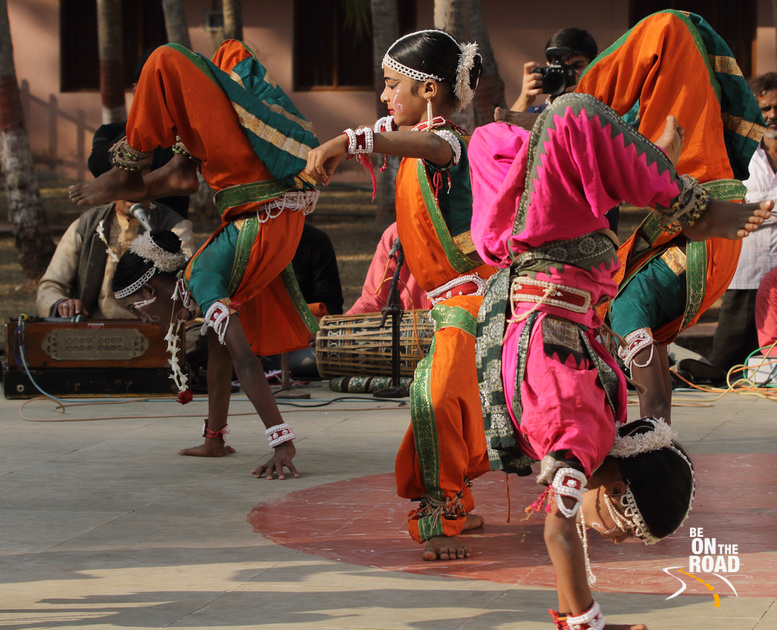Gotipua Dance of Odisha: Where boys dressed as girls perform with grace and acrobatics

It is an ancient dance form from the state of Odisha. Some even consider it to be the precursor to the modern day Odissi classical dance. It is a combination of masculine and feminine elements. It is a combination of grace and strength. I am referring to the traditional Gotipua dance of Odisha.
Gotipua (which literally translates into single boy), is a dance form that is believed to have originated in the Puri Jagannath temple many centuries back and whose heritage is kept alive in the tiny village of Raghurajpur. It is a group dance where the dancers praise Lord Jagannath and Krishna by enacting different stories from the life of Radha and Krishna. Beautifully decked dancers perform these stories with graceful movements and a rich show of acrobatics.

This dance form is unique in many ways.
1) Young boys transform themselves into graceful feminine dancers for this dance

2) Their femininity transforms into grace and poise, while their inner masculinity transforms into strength, acrobatics and yogic mudras
3) And most of them stop dancing once they hit puberty

Sounds interesting right? Well, to understand its uniqueness, you have to understand a bit of its history.
History of Gotipua dance

There are two prevalent theories when it comes to the history of Gotipua. One theory states that the Devadasi system gradually declined with the advent of the Mughals. The priests of the Puri Jagannath temple selected boys from poor families to dance for the deity and carry forward the legacy. The other theory is related to Chaitanya Mahaprabhu, the famous Bhakti saint, who wanted dance troupes to dance during the Rath Yatra. However, the temple priests declined his request citing menstruating devadasis would make the ceremony impure. So eventually young boys were chosen for this dance.
Lifecycle of Gotipua Dancers

Boys from poor families are chosen at a very young age (4 to 5 years old) and are taught the various nuances of this dance form under a guru. The parents agree for two reasons. One, they ae poor and two, they believe Gotipua is special and is reserved only for God’s children.
From the time they are enrolled into the dance school, these boys do not cut their hair and let it grow. They learn how to tie it into a knot and adorn their face with make-up, such as kajal, bindi and traditional paintings. They wear a traditional dress called Kanchula and nibibandha (a bright colored blouse and apron like silk cloth tied around the waist like a frill). Their palms and soles are anointed with a red liquid called Alta. And in addition, they wear necklaces, bracelets, armbands, nose rings, ear ornaments and others. Most of these are considered sacred.

They are then taught the entire repertoire of the Gotipua dance that includes the worship prayer (vandana), Sa ri ga ma dance, enactment of songs or ancient writings (Abhinaya) and acrobatic yogic postures (bandha Nrutya).
They keep learning, practicing and performing till they attain puberty or lose their boyish charms and grown into a man. And that is when they move into a different form of dance or they start grooming young Gotipua dancers themselves.

In a Gotipua dance performance, you get to feel the innocence of the child, the beautiful depiction of the Radha Krishna Leela through the various actions, the beauty, poise and grace of their outwardly feminine form and finally the sheer strength when they perform the stunning acrobatic stunts. All in all, this ancient dance form is as captivating as a modern one. And it is packed with a lot of energy too in addition to folklore, classical forms, music and mythology. A beautiful mix of art, emotion and storytelling that makes for a heady concoction. A must experience on a cultural trip to Odisha.

Where to experience this dance form in Odisha:
Most popular resorts showcase a Gotipua dance performance at their premises from time to time. And so do dance academies in Bhubaneshwar. But, if you wish to visit the roots and spend time with the actual dancers and the artisans, the heritage village of Raghurajpur would be your best bet.

How to get here:
The nearest domestic and international airport would be Bhubaneshwar, which is about 60 kms away. Bhubaneshwar or Puri would be your nearest railway and bus stations. Puri is 15 kms away from Raghurajpur, while Bhubaneshwar is 60 kms away. You can opt for local buses, auto rickshaws, cab services or drive on your own.

Best season to visit:
You can visit all year around, but it is prudent to avoid the hot summer months of March to June.

Where to stay here:
If simple rustic life is your thing, stay at any of the homes of the artisans in Raghurajpur.
If you need modern day comforts and luxury, opt to stay in Puri (about 15 kms away) or at Bhubaneshwar (about 60 kms away).

Nearby tourist attractions:
1) Heritage village of Raghurajpur known for its Pattachitra, Tadopatra and papier mache artisans
2) Pipili village known for its chandua artisans and their applique work
3) The UNESCO World Heritage site of Konark Sun Temple
4) Puri Jagannath temple, one of the char dhams and its beautiful beaches
5) Bhubaneshwar and its many intricate temples
6) The ancient cave temples at Udayagiri and Khandagiri
7) The historic Buddhist trail at Ratnagiri, Udayagiri and Lalitgiri



































